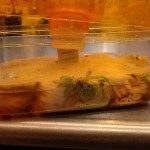Before leaving for vacation last year I bought 3 gorgeous, heads of Napa cabbage (Chinese cabbage) at a farmers market at Union Square and pickled them as my mother did every year at the end of the year. Pickled Napa cabbage, hakusai no tsukemono, which acquires delicious distinctive combined flavors of sweetness, sourness (lactic acid) and saltiness and crunchy texture from a month-long fermentation, entertained us at every meal in the following months until we all consume it with great sadness. I have not tasted my mother’s delicious hakusai no tsukemono since I left my home many years ago. I did not attempt to make it in the past until a couple of years ago, because the price and quality of available Napa cabbage in my neighborhood was not worth a try.
My mother owned two large wooden pickling barrels and couple of heavy pickling stones. Towards the end of the year the vegetable shop delivered to our house a dozen of huge Napa cabbage heads – 5 to 6 pounds a head. Making pickled cabbage in this quantity is a true labor. She first cut each cabbage into quarters lengthwise, rinsed them in a large bowl of cold water several times and transfer them to a bamboo basket, exposing them to dry, cool winter air on the balcony next to the kitchen before pickling them. According to my mother drying process concentrates the flavor in the cabbage, resulting producing better tasting pickles. She used only sea salt and aka-togarashi (Japanese dried small red chile pepper) for pickling the cabbage.
Here is my small production and shorter pickling recipe for you. Even 2 weeks pickling gives you wonderful fermented flavor of the cabbage. Once you taste the hakusai no tsukemono in this way you will be hooked up. Try this recipe with winter Napa cabbage. Napa cabbage increases sweetness in cold air. If you own a Japanese pickling pot (you see mine in the attached photo) making hakusai no tsukemono is a piece of cake. If not, you need a pickling stone (see the attached photo) or any heavy, hygienic item which can be used as a weight.
4 pound Napa cabbage
5 tablespoons sea salt
2 to 3 tablespoons Italian red chile pepper flakes
Cut the Napa cabbage into quarters lengthwise. Rinse each piece in a cold water in a large bowl, changing water several times. Drain the cabbages and transfer them to a large strainer placed over a large bowl. Leave the cabbages for 5 hours.
Have a pickling pot or bowl with a weight ready at hand. Pick up one piece of Napa cabbage and sprinkle with sea salt. Place the piece into the pickling pot or bowl. Sprinkle the surface with little chile pepper flakes. Repeat and finish salting, placing all of the pieces of the cabbages and peppering the surface. When you are using a pickling pot, cover the pot with a lid (which comes with a inner pressure board and a screw attached) and turn the screw to let the inner pressing board goes down as low as possible and the cabbages are pressed tightly. When using the bowl, cover the top of the cabbages with a plastic wrap, place a plate which is big enough to cover the most of the surface area, and place a 8-pound weight on top. Transfer the pickling pot or bowl to a refrigerator. Wait for 3 to 4 days until the water seeps out from the cabbages completely covers the cabbages. When it is confirmed, wait a day or two more before consumption. You can enjoy the pickles in the following 10 days or so.




